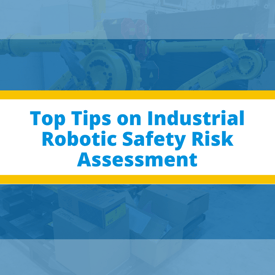 The use of industrial robots has brought a number of benefits to the workplace, but it has also increased the inherent risk posed to the workers on the plant. Thus, it is the responsibility of the manufacturer to ensure a safe working environment is maintained at all times.
The use of industrial robots has brought a number of benefits to the workplace, but it has also increased the inherent risk posed to the workers on the plant. Thus, it is the responsibility of the manufacturer to ensure a safe working environment is maintained at all times.
Safety is often viewed as an extra responsibility, something that comes with greater paperwork and overhead. The truth, however, is quite different. Having a safe working environment can actually have benefits such as assurance of regulatory compliance and increased productivity from the factory floor.
Assessing the risks associated with robotic technology is the very first step needed to get on the pathway of a safe environment. This has become a standardized process in several industries, and involves two steps:
- Risk analysis
- Risk evaluation
Risk analysis can be thought of as a detailed process which requires determination of the physical movement of the robots, identifying the hazards associated with their scope of work and estimating the risk involved. Risk evaluation focuses more on deciding how to remove the risk or minimize it if it can’t be removed entirely.
Getting Familiar with Safety Regulations
Before analyzing a plant floor for risks, it’s necessary to become familiar with the most up-to-date safety regulations and requirements. These are key to running a safe facility, and not following them properly can lead to heavy fines and penalties. Knowing what the regulations require can help identify hazards, determine the risks of said hazards, and evaluate those risks afterward.
Identifying Hazard Sources
While completing a risk assessment, the identification of hazardous sources in industrial robotics is one of, if not the most vital step. Hazards can include a wide variety of types including mechanical, electrical, ergonomic, and thermal.
The type of hazard that a robotic application may pose depends on its use and the physical parameters that govern the robot, such as its lifting capacity, range of motion, and interactions. For instance, a robot that lifts car chassis wouldn’t pose a risk if human operators were not allowed in its range of motion, and it works autonomously.
However, there are several robots that do require human interventions. For these, identification of hazards is necessary. Once done, risks must be mitigated through techniques such as laser fencing, event-based indications, and automated/manual emergency stop switches.
Inspecting Robots on the Plant Floor
Following up risk assessments with regular inspections is a smart way to make sure the robots remain safe for human interaction. Safety switches, sensors, laser fences, and indicator lights need to be checked to confirm they’re functioning properly. The robots should also be inspected to ensure there’s no damaged or improperly working parts. Once it’s clear that the robots and safety measures are all operating correctly, the plant floor can continue working as usual.
Training Workers
Another important tip for keeping the plant floor safe is properly training workers, operators, maintenance crew, and others to perform alongside robotic applications. This is especially important in situations with collaborative robots, which require human interaction to function. While these “cobots” have sensors and signals to operate safely around humans, there is always a possibility of injury. Thus, it’s important to make sure plant workers are equipped to work alongside the robots on the plant floor.
All in all, safety in an industrial environment is extremely important because enriching the content of humans’ lives is technology’s purpose.
Premier Automation designs and implements automatic robotics systems for industrial OEM and End User customers.



.png?width=669&name=Photography%20Email%20Header%20(2).png)
